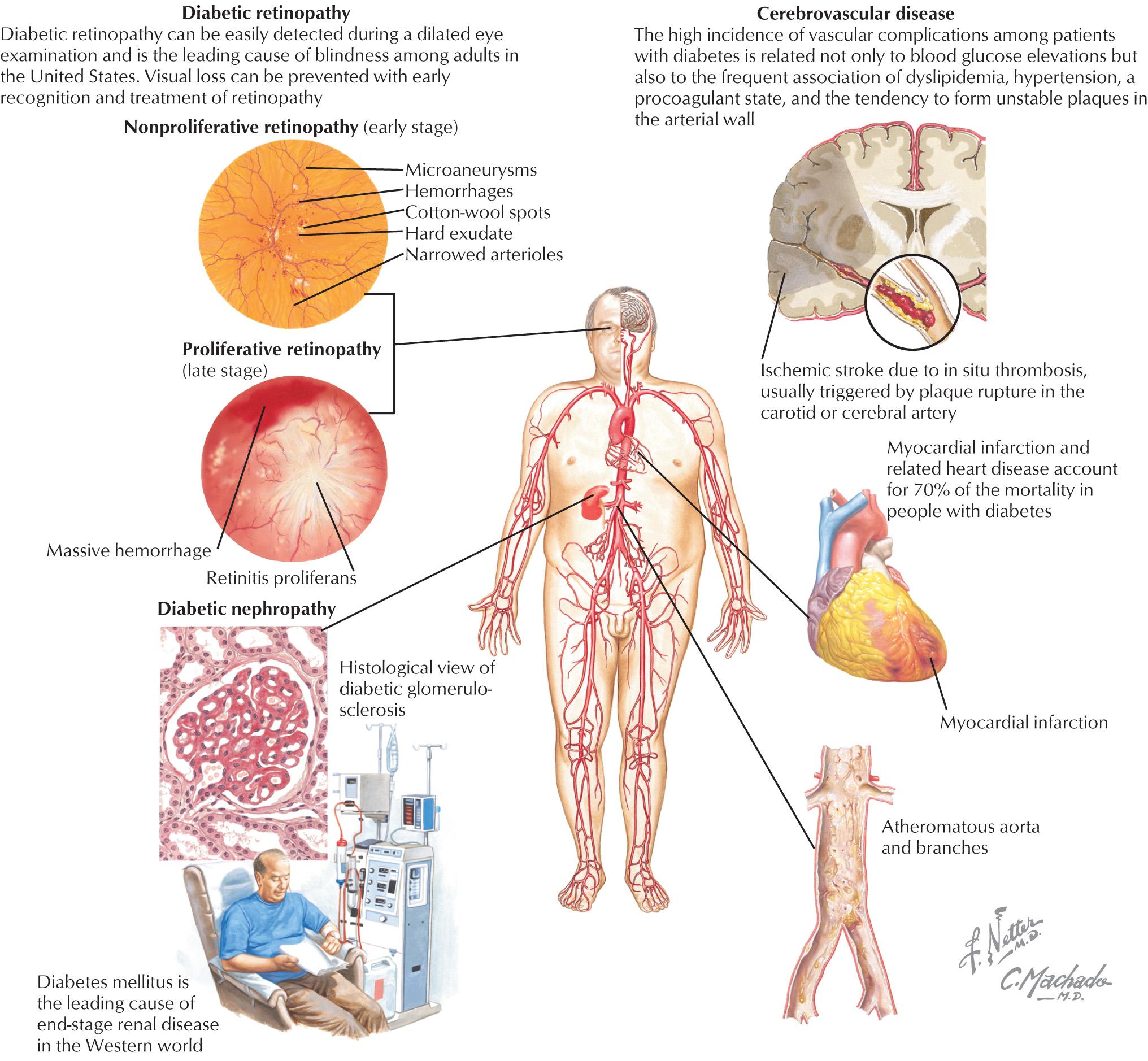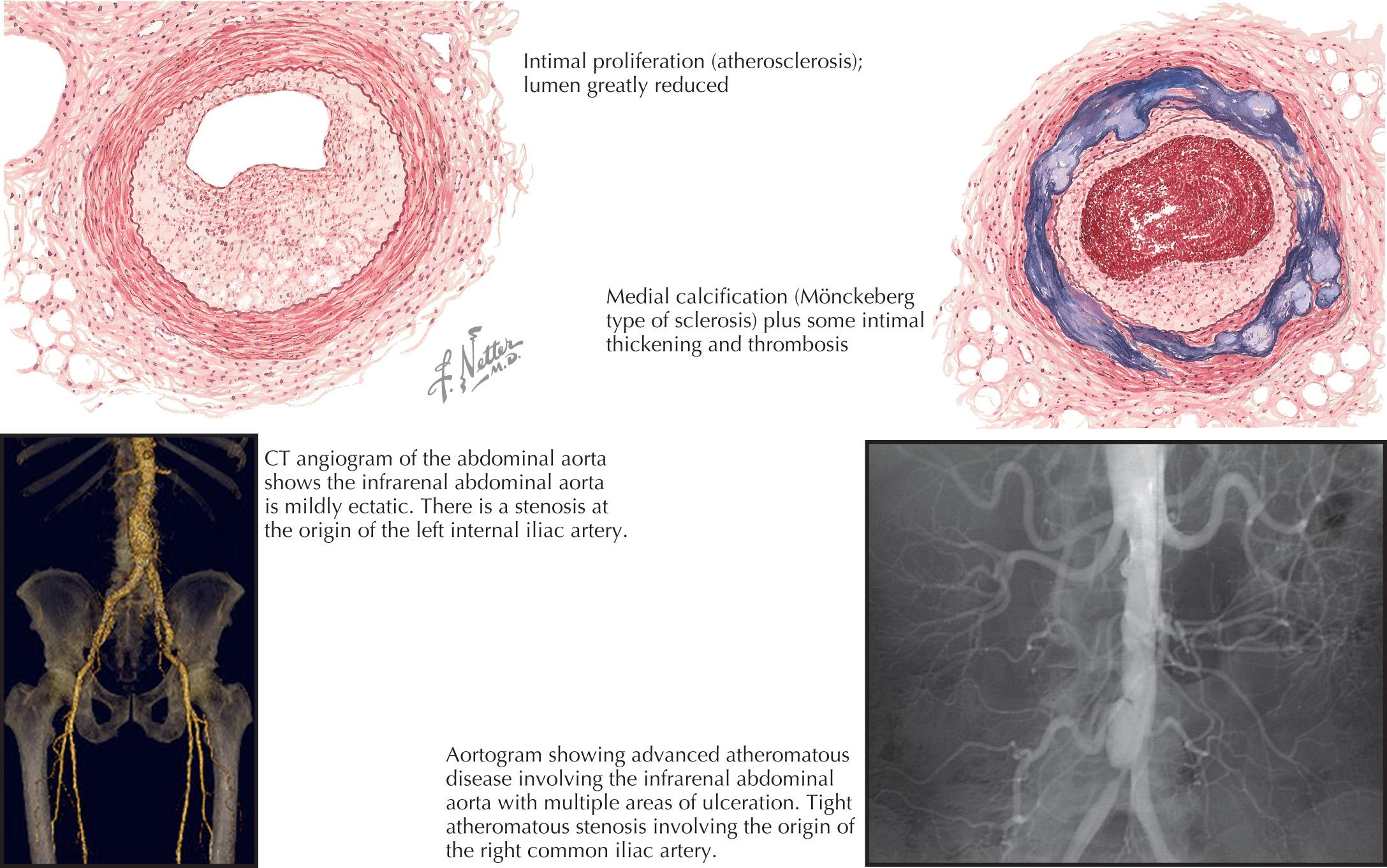Physical Address
304 North Cardinal St.
Dorchester Center, MA 02124
Diabetes mellitus is the resultant state of insulin deficiency that causes elevated blood glucose. The etiologies of this insulin deficiency can broadly be classified as either type 1 or type 2 diabetes. Type 1 diabetes is characterized by an autoimmune process that results in β-cell dysfunction and inadequate insulin production. This form of diabetes frequently presents during childhood or adolescence, and requires insulin supplementation due to the inadequate production of insulin by the pancreas.
Type 2 diabetes (T2DM) is more common in adults and is characterized by insulin resistance. Because most adult patients have T2DM, it is this group that will be the focus of this chapter. All of the mechanisms that underlie the development of insulin resistance have not been fully elucidated. It is likely that the disease is caused by the interaction of multiple different factors, including genetic, environmental, and lifestyle factors, all of which contribute to the development of the disease. It is clear that obesity plays a central role and decreases the body's responsiveness to insulin. This decrease in the response to insulin is known as insulin resistance, and patients with insulin resistance are considered to have prediabetes. In patients with prediabetes, higher levels of insulin are required to maintain glucose homeostasis. These increased demands on the pancreas place the insulin-producing β cells under stress. Ultimately, the pancreas is no longer able to produce enough insulin to maintain euglycemia, and thus, hyperglycemia results. These patients are considered to have progressed from prediabetes to T2DM. In patients with longstanding and poorly controlled T2DM, insulin production can fall, exacerbating the insulin deficiency and excess hepatic glucose production, which results in physiology that can resemble T1DM.
The presence of T2DM increases the risk of multiple adverse health events, including death. Broadly speaking, diabetes complications can be divided into those that are microvascular or macrovascular in origin ( Fig. 17.1 ). Microvascular disorders include retinopathy (diabetes remains a leading of blindness), nephropathy (which can lead to end-stage renal disease), and neuropathy. Macrovascular complications from diabetes refer to those events that are predominately seen in larger caliber vessels and include myocardial infarction, stroke, and peripheral arterial disease. Patients with diabetes are at considerably higher risk of atherosclerosis and ischemic events.

Multiple biological mechanisms link diabetes and atherosclerosis. The higher burden of atherosclerosis seen in patients with diabetes is related partially to the direct effects of hyperglycemia. Hyperglycemia increases the proliferation of vascular smooth muscle cells that causes vascular beds to have diffusely diseased vessels and decreased capacity for delivery of blood ( Fig. 17.2 ). Hyperglycemia also results in oxidative stress and the formation of reactive oxygen species, which, in turn, promote lipid oxidation, endothelial damage, inflammation, and progression of lipid-rich plaques. Finally, alterations in lipid metabolism and the association of hypertension and obesity that occur frequently in patients with diabetes also contribute to the development of atherosclerosis and the increased risk of cardiovascular events seen in this population.

In addition, it is becoming increasingly clear that patients with diabetes are also at increased risk of heart failure. The relationship between diabetes and heart failure has been known for some time; however, it was believed that diabetes predominately increased the risk for ischemic cardiomyopathies secondary to the higher rates of coronary artery disease seen in this population. Although coronary artery disease remains a significant risk factor for heart failure, it has been shown that the relationship between diabetes and heart failure is independent of the presence of atherosclerosis. In the REduction of Atherothrombosis for Continued Health (REACH) registry, which is a large international registry of patients with either established atherosclerosis or at high risk for atherosclerosis, patients with previous myocardial infarction or stroke had higher rates of heart failure than patients without established cardiovascular disease. However, the presence of diabetes resulted in a similar relative increase in the risk of heart failure, regardless of whether patients had a previous ischemic event or only had risk factors for heart failure. Patients with diabetes are at risk for heart failure with preserved ejection fraction, and this form of heart failure occurs independently from coronary artery disease. Although diabetes also increases the risk of other events (e.g., infections), preventing microvascular, macrovascular, and heart failure complications are the dominant goals of the current therapies for diabetes.
The prevalence of diabetes is increasing across the world. In 1980, it was estimated that 108 million people had diabetes, and that is affected approximately 4.3% of the world's population. Over the past 25 years, the rate of diabetes has grown exponentially, such that in 2014, it was estimated that diabetes was present in 422 million people worldwide and affected approximately 9% of men and 8% of women. Although some of this increase is believed to be secondary to aging of the population, overall increases in the prevalence of obesity are thought to be a considerable driver for the more than fourfold increase in prevalence. The incidence rate of diabetes is expected to continue to climb, and some studies have suggested that >700 million people may have diabetes by 2025.
There are multiple risk factors for the development of diabetes, including genetic predisposition, caloric intake and/or diet, and physical activity (or the lack thereof). All of these issues factor into the risk of developing diabetes. Ultimately, the rates of T2DM are closely linked with the presence of obesity. Most increases in the prevalence of diabetes are at least somewhat linked with the increasing incidence of obesity. Although diabetes and obesity are increasing in the United States, the rates of diabetes are increasing at the highest absolute rates in the developing world. This increase appears to be due, at least in part, to the increase of high caloric diets and decreases in energy use as these societies move from predominately agrarian to more industrialized ways of life. Efforts to prevent the increase in the prevalence of diabetes are focused on the developing world because these increases are contributing significantly to the overall increase in the incidence of diabetes.
Patients with diabetes have higher rates of death compared with patients without diabetes. When evaluating the reasons for the differential rates of death, the largest contributor to the excess in deaths in patients with diabetes are cardiovascular events. Thus, targeting cardiovascular events is likely the most effective strategy to improve outcomes in patients with diabetes. Although rates of cardiovascular complications are declining, both in the general population and in patients with diabetes, the large increases in the number of patients with obesity and diabetes may threaten the long-term decreases in the cardiovascular event rate.
The duration of diabetes and degree of glycemic control with diabetes is a significant predictor of future diabetes complications. Previous studies have shown that glycosylated hemoglobin (HbA 1c ), which is a marker of glucose levels over the previous 3 months, predicts cardiovascular events in patients both with and without established diabetes. The duration of diabetes is also a significant independent predictor of future diabetes complications. Thus, identification of patients at risk for diabetes, prediabetes, and new-onset diabetes allows for intensified therapy that may mitigate the risk of long-term complications from diabetes.
The American Diabetes Association (ADA) has identified some important risk factors associated with the development of diabetes: lack of physical activity; patients of African American, Latino, Native American, Asian American, Pacific Islander race or ethnicity; patients with a family history of diabetes (particularly those with first-degree relatives who have diabetes); women previously diagnosed with gestational disease; patients with hypertension; patients with low high-density lipoprotein cholesterol (<35 mg/dL) and/or high triglycerides (>250 mg/dL); patients with evidence of insulin resistance (HbA 1C ≥5.7%); patients with impaired glucose tolerance (glucose of 140–199 mg/dL on a 2-hour glucose tolerance test) or impaired fasting glucose (100–125 mg/dL); patients with severe obesity; patients with acanthosis nigricans and/or polycystic ovarian syndrome; patients with hypertension (≥140/90 mm Hg or on treatment); and patients with a known cardiovascular disease are all independent predictors of having diabetes.
Current guidelines recommend screening for diabetes in patients who are overweight and/or obese and have at least one of the previously mentioned risk factors for diabetes. The diagnosis of diabetes requires the presence of at least one of four different clinical findings: (1) fasting plasma glucose of ≥126 mg/dL; (2) oral glucose tolerance test (with equivalent of 75 g anhydrous glucose dissolved in water) with a 2-hour postprandial glucose of ≥200 mg/dL; (3) HbA 1C ≥6.5%; or (4) random plasma glucose of ≥200 mg/dL.
Patients are considered to have prediabetes if the HbA 1c is between 5.7% and 6.4% (additional criteria for prediabetes include fasting plasma glucose between 100 and 124 mg/dL or glucose tolerance test with 2-hour glucose between 140 and 199 mg/dL). Patients with prediabetes are at increased risk of developing diabetes over time, and patients with tests closer to the upper range for prediabetes have a greater risk than patients with test results that are closer to the lower range. Patients with diabetes should be encouraged to begin exercise programs, work to lose weight, initiate therapies designed to modify cardiovascular risk factors, and reduce the risk of cardiovascular events. Previous studies have found that exercise and weight loss are particularly efficacious in reducing the risk of developing diabetes.
Become a Clinical Tree membership for Full access and enjoy Unlimited articles
If you are a member. Log in here